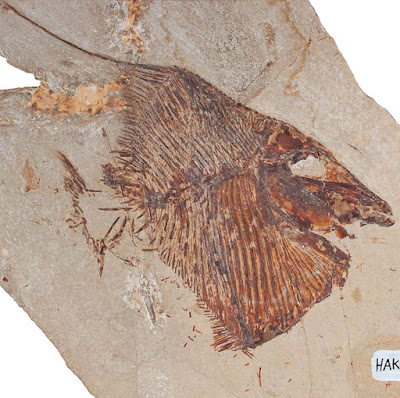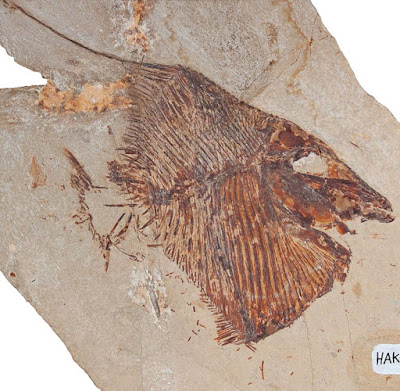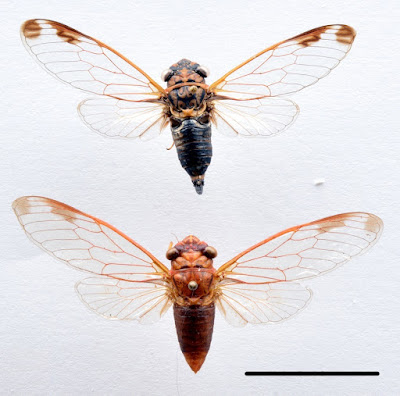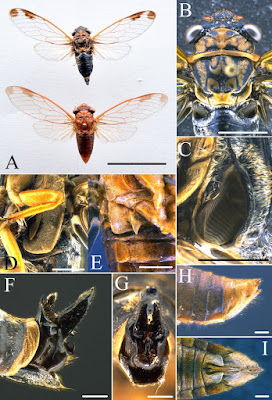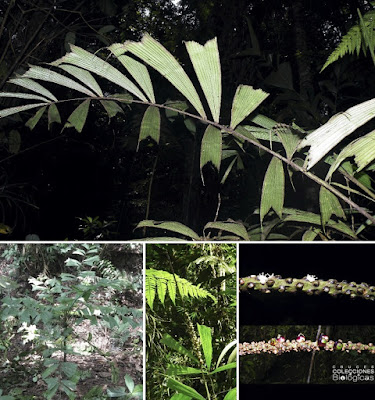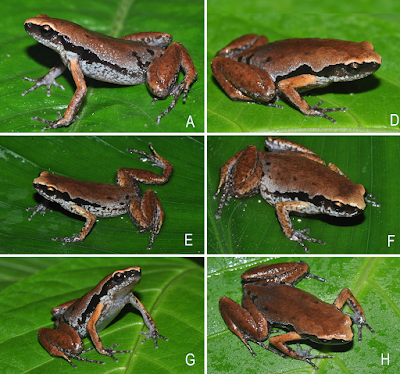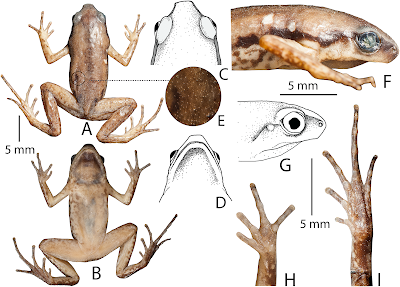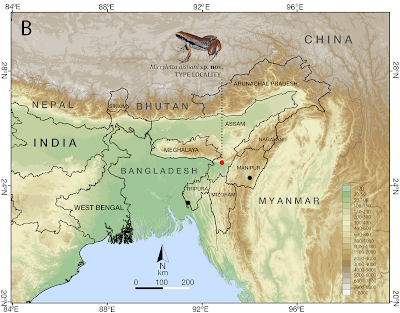[Most Recent Entries] [Calendar View]
Tuesday, June 11th, 2019
| Time | Event | ||||||
| 7:20a | [PaleoIchthyology • 2019] Flagellipinna rhomboides • A New Genus and Species of Pycnodontid Fish (Neopterygii, Pycnodontiformes), from the Upper Cretaceous (Cenomanian) of Lebanon, with Notes on Juvenile Form and Ecology
ABSTRACT The Upper Cretaceous (Cenomanian) limestone quarry of Haqel, Lebanon, is home to one of the largest diversities of fossil actinopterygians in the Mesozoic, particularly of pycnodontiform fishes. Here, we describe a pycnodontiform fish, Flagellipinna rhomboides, gen. et sp. nov., from this locality based on four specimens. It is considered a member of the derived family Pycnodontidae due to the presence of a postparietal process. This taxon is distinct from other pycnodontids due to its diamond-shaped body, whip-like dorsal fin, postcloacal scales with forward-pointing spines, and acute anterior profile with a concave slope, giving it a ‘hunchback’ appearance. The prognathous snout armed with molariform teeth suggests that this pycnodont preyed on a variety of shelled animals from crevices. The smallest specimen is distinct in that it has a larger orbit size, no spines on the contour scales, poorly ossified skull roof bones, a notochord partially covered by arcocentra, and lacks whip-like filament on the dorsal fin, which suggest that it is a juvenile/subadult. The differences between the juvenile/subadult and other larger specimens suggest a change in ecological niche occupation during ontogeny, going from a generalized forager that lived in complex, reef habitats to moving into deeper waters to feed from crevices on the reef edge. These findings provide a more complete picture of the possible life history strategies that pycnodontiforms may have used in order to exploit different resources throughout their lives.
SYSTEMATIC PALEONTOLOGY Class OSTEICHTHYES Huxley, 1880 Subclass ACTINOPTERYGII Cope, 1887 Series NEOPTERYGII Regan, 1923 Order PYCNODONTIFORMES Berg, 1937 Family PYCNODONTIDAE sensu Nursall, 1996 FLAGELLIPINNA, gen. nov. Age— Early late Cenomanian, Late Cretaceous. Type Species— Flagellipinna rhomboides, sp. nov. Etymology— The name is a combination of the Latin words ‘flagellum’ (whip) and ‘pinna’ (fin), which refers to the whip-like dorsal fin present in this genus. FLAGELLIPINNA RHOMBOIDES, sp. nov. Diagnosis— Small pycnodontid fish with a deep, rhomboid body shape. Anterior profile of the fish is extremely steep, being sloped at a mean 57.3° angle in relation to the vertebral column. Dorsal fin has a whip-like filament. Dorsal and anal pterygiophores inserted very deeply into the body. Dorsal and anal fins falcate anteriorly and become progressively strap-like posteriorly. Ventral apex present anterior to the insertion of anal fin. Two dentalosplenial (dentary) teeth are broad and incisiform, and the anterior (mesial) premaxillary tooth is bicuspid. Skull dorsoventrally flattened and obliquely oriented, with an elongate snout. Paired preparietal (prefrontal) bone present. Dermocranial fenestra absent in skull roof. Cleithrum narrow and elongate with just two limbs, the dorsal limb being far narrower than the ventral limb. Large, semicircular preoperculum with small exposed dermohyomandibular. Comparatively large operculum broad and club-shaped. Notochord completely surrounded by arcocentra. Ten to 15 dorsal ridge scales with three to six backward-pointing spines. Ventral ridge scales consist of 11 precloacal scales, with two backward curved spines and a single postcloacal scale. Cloaca is roofed by two comma-shaped scales. Four spines present on the postcloacal ventral ridge scale, with the first three being strongly curved and forward pointing and the most posterior spine straight and backward pointing in a posteroventral angle. Complete scales restricted to abdominal region, scale bars on rest of body. Type Locality and Horizon—Haqel, northern Lebanon; Sannine Formation, early late Cenomanian, Upper Cretaceous. Etymology— Latin for ‘rhomboid’ in allusion to the diamond-like body shape of the new species. CONCLUSIONS: Flagellipinna rhomboides, gen. et sp. nov., is a recent addition to the high biodiversity of the exceptional pycnodont fauna of the Cenomanian Lebanese fossil beds (Appendix 1). Anatomical characters such as the presence of a postparietal process indicate that this taxon is a pycnodontid, which are well represented in the Cenomanian of Lebanon (Appendix 1). The characteristics distinguishing Flagellipinna, gen. nov., from other pycnodonts is its acute anterior profile with a diamond-shaped body; a reduced operculum, which is nevertheless broader than typical pycnodont opercula and lies posterior to the dermohyomandibular and the preoperculum; a narrow and elongate cleithrum with two limbs; a posteroventral spine of the postcloacal scale, which is straight and backward pointing alongside three forward-pointing spines; a dorsoventrally flattened skull with a prognathous snout; a deep insertion of the dorsal and anal pterygiophores; and whip-like extended dorsal fin rays reminiscent of modern coral reef fishes such as Zanclus cornutus. A combination of inferences from the specimens, the paleoenvironment of Haqel, and the invertebrate fauna that were found alongside Flagellipinna, gen. nov., suggests that it possibly inhabited reef slopes and fed from crevices on elusive armored prey such as bivalves, echinoderms, and gastropods. The interpretation of the smallest specimen of Flagellipinna, gen. nov., being a juvenile raises interesting questions regarding ontogeny and change in ecology during growth of this fish. The juvenile has an even deeper body shape than the adult along with a shift in skull position and shape, indicating that it was a more typical durophagous pycnodont that lived in shallower reef habitats and may have moved into deeper waters to feed from the crevices of the reef edge as it became older. Of course, more specimens of Flagellipinna, gen. nov., are necessary in order to confirm the validity of these morphological changes throughout its ontogeny, but this interpretation is supported by similar ontogenetic changes observed in modern taxa. The Lebanese Cenomanian pycnodont fauna contains some of the most diversified assemblages of non-teleost actinopterygians in the Cretaceous. Such a diverse range of forms must have had a wide range of ecological requirements and life histories. Flagellipinna rhomboides, gen. et sp. nov., is not only another new species from this extraordinary assemblage, but the specimens described here also hint at how these fishes could have filled a particular niche in the Haqel ichthyofauna and how that niche may have changed during its life span. John Joseph Cawley and Jürgen Kriwet. 2019. A New Genus and Species of Pycnodontid Fish Flagellipinna rhomboides, gen. et sp. nov. (Neopterygii, Pycnodontiformes), from the Upper Cretaceous (Cenomanian) of Lebanon, with Notes on Juvenile Form and Ecology. Journal of Vertebrate Paleontology. DOI: 10.1080/02724634.2019.1614012 | ||||||
| 8:45a | [Entomology • 2019] Zelandoperla maungatuaensis • A New Flightless Stonefly Species (Plecoptera: Gripopterygidae) from Otago, New Zealand
ABSTRACT A new wing-reduced species of the stonefly genus Zelandoperla Tillyard is described from Otago, New Zealand. Zelandoperla maungatuaensis sp. n. differs from a related species, Z. denticulata, primarily by lacking full wing development. We used morphological, geographical, and genetic evidence to assess the proposed status of Z. maungatuaensis sp. n. and Z. denticulata as separate monomorphic species, as opposed to conspecific members of a polymorphic species. High genetic divergence was found between distinctly allopatric populations, supporting the status of Z. maungatuaensis sp. n. as a distinct monomorphic species. KEYWORDS: Gripopterygidae, microptery, new species, taxonomy, wing reduction
Family Gripopterygidae Subfamily Zelandoperlinae Genus Zelandoperla Tillyard, 1923 Zelandoperla maungatuaensis sp. n. Foster, 2019 Etymology: The specific epithet refers to the type locality Maungatua, which is derived from the Māori words maunga-atua, meaning ‘hill of the spirits’. Suggested common name: the Maungatua stonefly. Brodie J. Foster, Graham A. McCulloch and Jonathan M. Waters. 2019. Zelandoperla maungatuaensis sp. n. (Plecoptera: Gripopterygidae), A New Flightless Stonefly Species from Otago, New Zealand. New Zealand Journal of Zoology. DOI: 10.1080/03014223.2019.1624266 Zoologists discover 2 million-year-old insect species near Dunedin stuff.co.nz/environment/113330758/zoolog | ||||||
| 8:48a | [Entomology • 2019] The Cicada Genus Selymbria Stå1, 1861 (Hemiptera: Cicadidae: Tibicininae: Selymbrini): Redescription including Ten New Species and A Key to the Genus
Abstract The cicada genus Selymbria Stål, 1861 is redescribed along with ten new species. Selymbria boliviaensis n. sp. is described from Bolivia, S. chevauxensis n. sp. and S. guianensis n. sp. are described from French Guiana, S. cinctifera n. sp. is described from Panama and Costa Rica, S. ecuadorensis n. sp. is described from Ecuador, S. guatemalensis n. sp. is described from Guatemala, S. iguazuensis n. sp. is described from Argentina and Brazil, S. loretoensis n. sp. and S. madredediosensis n. sp. are described from Peru, and S. puntarenasensis n. sp. is described from Costa Rica. The current sixteen species of Selymbria are listed along with their synonymies and the known distribution of each species. A key to the species of Selymbria is provided. Keywords: Hemiptera, Taxonomy, new species, Neotropics, Central America Allen F. Sanborn. 2019. The Cicada Genus Selymbria Stå1, 1861 (Hemiptera: Cicadidae: Tibicininae: Selymbrini): Redescription including Ten New Species and A Key to the Genus. Zootaxa. 4614(3); 401–448. DOI: 10.11646/zootaxa.4614.3.1 | ||||||
| 8:51a | [Crustacea • 2019] Geosesarma spectrum • A New Species of Semiterrestrial Vampire Crab (Decapoda: Brachyura: Sesarmidae) from Brunei Darussalam, Borneo
Abstract A new semiterrestrial vampire crab from the family Sesarmidae, Geosesarma spectrum n. sp., is described from Brunei Darussalam (Borneo). The new species is characterised by its colouration in life, relatively large size, and form of the carapace, ambulatory legs and gonopods. The new species is compared to its closest congeners from Borneo. This description brings the number of Geosesarma species to 60. Keywords: Crustacea, taxonomy, Grapsoidea, semiterrestrial crab, taxonomy, Brunei Darussalam, Southeast Asia  Paul Y. C. Ng and Peter K. L. Ng. 2019. Geosesarma spectrum, A New Species of Semiterrestrial Vampire Crab (Crustacea: Decapoda: Brachyura: Sesarmidae) from Brunei Darussalam, Borneo. Zootaxa. 4614(3); 529–540. DOI: 10.11646/zootaxa.4614.3.6 | ||||||
| 10:06a | [Botany • 2019] Aiphanes suaita (Arecaceae) • A New, Overlooked Species of Aiphanes from Santander, Colombia
Abstract The new species Aiphanes suaita, from the Eastern Cordillera of Colombia, is described and illustrated. Previous specimens of this species had been mistaken for Aiphanes simplex, but a molecular phylogeny revealed that it is actually more closely related to Aiphanes leiostachys, from the Central Cordillera, prompting a reexamination of the specimens. The new species differs in its solitary stem, lack of yellowish spines, pinnae strongly plicate along secondary veins, spicate inflorescences, staminate flowers with the axis perpendicular to the spike axis, and triad bracts short, with smooth margin. Based on IUCN criteria, it is categorized as Endangered. Keywords: cryptic species, endangered species, palms, South America, Monocots
Aiphanes suaita R. Bernal, Sanín & Castaño, sp. nov. Diagnosis :— Aiphanes suaita resembles Aiphanes simplex in its small size, short, cuneate pinnae, and spicate inflorescence. However, it differs from that species in its solitary stem, 3 cm diam. (vs. stems densely cespitose, up to 20 per plant, 1−2 cm diam.), the dark brown spines on the leaf sheath and the petiole (vs. yellowish spines), and the arrangement of the staminate flowers on the inflorescence axis. .... Etymology :— The epithet suaita is a noun used in apposition. It is the name of the municipality where the new species was first located, the same name that the aboriginal village of the Guane Indians had at the time of the Spanish invasion (Pita Pico 2013). Rodrigo Bernal, Felipe Castaño and María José Sanín. 2019. A New, Overlooked Species of Aiphanes (Arecaceae) from Santander, Colombia. Phytotaxa. 405(2); 101–105. DOI: 10.11646/phytotaxa.405.2.5 | ||||||
| 11:08a | [Herpetology • 2019] Micryletta aishani • A New Species of Micryletta Frog (Microhylidae) from Northeast India
Abstract We describe a new species of frog in the microhylid genus Micryletta Dubois, 1987 from Northeast India based on molecular and morphological evidence. The new species, formally described as Micryletta aishani sp. nov., is phenotypically distinct from other congeners by a suite of morphological characters such as brown to reddish-brown dorsum; dorsal skin shagreened with minute spinules; snout shape nearly truncate in dorsal and ventral view; a prominent dark streak extending from tip of the snout up to the lower abdomen; ash-grey mottling along the margins of upper and lower lip extending up to the flanks, limb margins and dorsal surfaces of hand and foot; tibiotarsal articulation reaching up to the level of armpits; absence of outer metatarsal tubercles; and absence of webbing between toes. Phylogenetic relationships within the genus are inferred based on mitochondrial data and the new taxon is found to differ from all the recognised Micryletta species by 3.5–5.9% divergence in the mitochondrial 16S rRNA. The new species was found in the states of Assam, Manipur, and Tripura, from low to moderate elevation (30–800 m asl) regions lying south of River Brahmaputra and encompassing the Indo-Burma Biodiversity Hotspot. The discovery validates the presence of genus Micryletta in Northeast India based on genetic evidence, consequently confirming the extension of its geographical range, westwards from Southeast Asia up to Northeast India. Further, for nomenclatural stability of two previously known species, Microhyla inornata (= Micryletta inornata) and Microhyla steinegeri (= Micryletta steinegeri), lectotypes are designated along with detailed descriptions. Micryletta aishani sp. nov. Northeast Indian Paddy Frog Etymology. The species epithet, aishani, is an invariable feminine noun derived from the Sanskrit word ‘aishani’ or aiśānī (meaning north-east), referring to the Northeast regions of India where this frog was discovered. Diagnosis. The new species is assigned to the genus Micryletta due to the following combination of morphological traits: small body size (SVL 22–28 mm); absence of vomerine teeth; prominent subarticular tubercles on fingers and toes; finger and toe tips slightly expanded in to small discs; and absence of webbing between fingers and toes (Dubois, 1987; Fei et al., 2009). Micryletta aishani sp. nov. differs from the other recognised species of the genus by the following suite of morphological characters: relatively small adult size (SVL 22.1–23.5 mm, male, N = 7; SVL 25.6–27.3 mm, female, N = 4); slender body; snout nearly truncate in dorsal and ventral view, acute in lateral view; tibiotarsal articulation reaching up to the level of armpit when stretched forward along the body axis; dorsal skin shagreened with minute spinules; outer metatarsal tubercles absent; webbing between toes absent; dorsum brown to reddish-brown with a faint brown median band extending from margins of the upper eye lids and tapering up to the vent, and few scattered blackish-brown spots on posterior parts of the back and near the groin; lateral surfaces of head blackish-brown; prominent blackish-brown streak extending from tip of the snout up to lower abdomen; ash-grey mottling along the margins of the upper and lower lip, extending up to the flanks and the limb margins; anterior and posterior parts of thigh, tarsus, and dorsal surfaces of hand and foot brown with ash-grey mottling; iris bicoloured, upper half light brown and lower half dark brown; belly ash-grey with a purplish tinge and brown mottling towards the margins.
Distribution and natural history. Micryletta aishani sp. nov. is currently known from three Northeast Indian states of Assam, Tripura, and Manipur (Fig. 1). At the type locality (Subhong), we came across a large aggregation of calling males in the month of May at around 8.30 pm. Individuals were calling from waterlogged fern banks located at the base of a small valley between hillocks (locally called Tillas). The area is characterised by degraded forest with areca nut plants and beetle vine cultivation located close to a human settlement (∼1 km). Two females were collected from the exposed slopes of the tillas close to the congregation. The species seems to have a narrow breeding season with very specific requirements as we failed to record any individuals either before waterlogging (during early April) or once the fern banks began to submerge in water (by June). Among other anurans in the same habitat, we recorded Microhyla mymensinghensis Hasan, Islam, Kuramoto, Kurabayashi, and Sumida, Kurixalus sp., Rhacophorus smaragdinus Blyth, Raorchestes sp., and Humerana humeralis Boulenger. At Tripura and Manipur, individuals were collected from ground or leaf litter near shallow streams and marshy areas covered with thick vegetation. Collection sites were located in degraded secondary forest areas close to human settlement.
Conclusions: Our description of a new species of Micryletta from Northeast India contributes to a better understanding of the diversity in this genus. The discovery also genetically validates the presence of the genus Micryletta in India and the westward extension of its geographical range within South Asia. The study provides evidence for genotypic and phenotypic distinctness of the new species from all the previously recognised congeners, designates lectoptypes for nomenclatural stability of two previously known species, and confirms the presence of additional undescribed lineages within the genus. Altogether, our work will facilitate future taxonomic, phylogenetic, and biogeographical studies in this microhylid group. Abhijit Das, Sonali Garg, Amir Hamidy, Eric N. Smith and S. D. Biju. 2019. A New Species of Micryletta Frog (Microhylidae) from Northeast India. PeerJ. 7:e7012. DOI: 10.7717/peerj.7012 |
| << Previous Day |
2019/06/11 [Calendar] |
Next Day >> |
